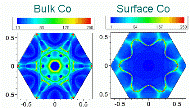Department of Physics and Astronomy: Publications and Other Research
Date of this Version
4-1-1987
Abstract
The lowest energies of molecular systems with fourfold symmetry can violate Hund's multiplicity rule. We derive relationships between two electron integrals that in favorable cases allow one to predict when this will happen. These relationships result in a fairly simple inequality as a criterion. The systematics of the phenomenon are illustrated with a series of calculations on model systems consisting of hydrogen atoms. These are rings of three, four, five, six, seven, and eight members as well as octahedral and square planar arrangements. These show how the results and simple ideas of molecular orbital theory can be qualitatively modified when various levels of configuration interaction are allowed in the theoretical discription. The Journal of Chemical Physics is copyrighted by The American Institute of Physics.


Comments
Published by American Institute of Physics. J. Chemical Physics 86, 4018 (1987). ©1987 American Institute of Physics. Permission to use. http://jcp.aip.org/.